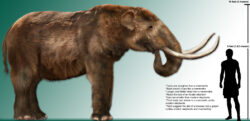Paleoindian Period
People from the Clovis culture and San Patrice culture were some of Louisiana’s earliest inhabitants.
This entry is 4th Grade level View Full Entry

Dantheman9758, Wikimedia Commons, CC 3.0
Paleoindians shared the land with megafauna, including mastodons.
What was the Paleoindian period like?
The Paleoindian (Old Indian) period began about 13,000 years ago and lasted until about 10,000 years ago. Early in this period, plants and animals, as well as shorelines and river courses, were very different than they are today. Because the Earth was colder, much of the planet’s water was frozen as glacial ice. The coast of Louisiana extended up to seventy miles further south than where it is today! Paleoindians shared their land with megafauna (big animals) like mastodons, mammoths, and giant sloths.
What cultures lived in North America and Louisiana during the Paleoindian period?
The Clovis culture is the name archaeologists have given to a group of people who lived in the United States during the Paleoindian period from about 9500 to 8800 BCE. The people of the Clovis culture are famous for making distinctive stone spear points, which are found all over the United States. These spear points were crafted with considerable skill. Since these points are found over such a big area, archaeologists used to believe that Clovis hunters followed herds of megafauna over huge areas and that they mostly ate meat from these animals. However, their diet also included smaller animals like frogs, birds, and turtles. The Clovis culture disappeared around 10,000 years ago due to climate change and the extinction of most megafauna.
The people of the San Patrice culture also lived during the Paleoindian period. They emerged as the Clovis culture disappeared (around 8800 BCE) and lasted until about 6000 BCE. The San Patrice culture also made stone spear points, but these were smaller than the Clovis point and were shaped differently. This difference may be because the San Patrice culture began using the atlatl, or spear thrower. The smaller points, mounted on lightweight spears, worked better with the atlatl. Atlatls greatly increased the speed and distance a spear could be thrown. The San Patrice culture developed at a time when the environment was changing from earlier Ice Age conditions to the more modern landscape. Plant and animal remains have not been recovered from a San Patrice culture site in Louisiana, so information on what they ate is limited. Research at sites in surrounding states suggest that the San Patrice culture hunted bison in grasslands and pursued deer, fish, turtles, and rabbits in woodlands and bottomlands.
